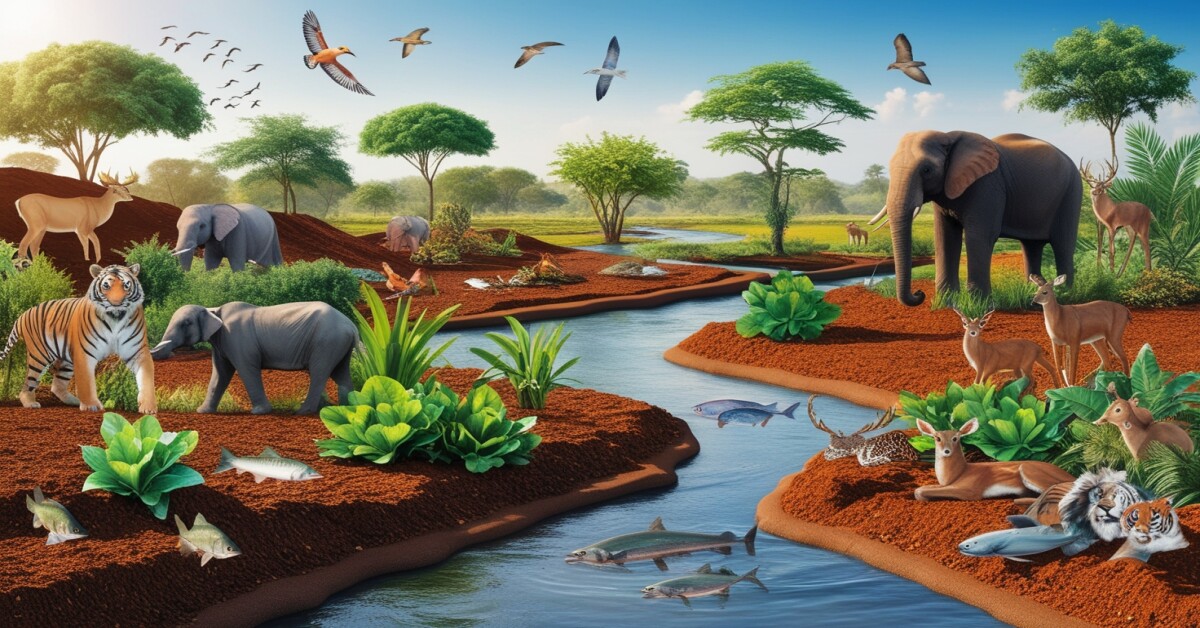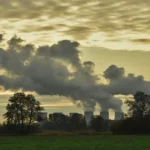Land, soil, water, vegetation, and wildlife are essential parts of our planet. They form the foundation of life on Earth. Together, they create ecosystems that support plants, animals, and humans. Each element plays a unique role.
For example, land provides space for habitats, while soil helps plants grow by supplying nutrients. Water is vital for all living things, and vegetation prevents soil erosion. Wildlife completes this balance by maintaining biodiversity.
Understanding the connection between these elements is important. Healthy soil and water lead to thriving vegetation, which supports wildlife. However, when one is damaged, the others suffer too. For instance, deforestation harms wildlife and increases soil erosion.
Therefore, preserving this relationship is crucial. It not only ensures biodiversity but also supports human needs like food, clean water, and oxygen.
Overview of Land, Soil, Water, and Wildlife
Land, soil, water, and wildlife are the building blocks of life on Earth. Each plays a crucial role in maintaining balance in nature.
Land serves as the foundation for ecosystems, providing space for plants, animals, and human activities. Without land, habitats for wildlife and areas for farming or living wouldn’t exist. Its importance lies in its ability to support all forms of life.
Soil is more than just dirt; it is a vital medium for vegetation growth. It provides nutrients that plants need to thrive. Healthy soil also prevents erosion and helps regulate water cycles.
For example, forests with rich soil hold water better, ensuring stability for plants and animals. When soil degrades, vegetation suffers, affecting ecosystems as a whole.
Water is the most essential resource for sustaining life. It quenches thirst, supports agriculture, and helps ecosystems function. Besides, water keeps soil fertile and supports vegetation growth.
Wildlife, too, relies on clean water sources for survival. Rivers, lakes, and oceans are lifelines that connect ecosystems and ensure the survival of countless species.
Wildlife, on the other hand, is an integral part of natural ecosystems. Animals, birds, insects, and aquatic species interact with vegetation and soil to maintain biodiversity.
For example, bees pollinate plants, and animals distribute seeds, helping ecosystems thrive. The loss of wildlife disrupts this delicate balance and harms other components like vegetation.
Together, these elements create a harmonious cycle. Land provides a home, soil nurtures plants, water sustains life, and wildlife ensures balance. Their collective role in nature is irreplaceable. Therefore, protecting these resources is essential for a healthy and sustainable planet.
Interdependence Between Land and Soil
The quality of soil is directly linked to how land is used and managed. Productive land use, such as farming or reforestation, supports healthy soil by maintaining its nutrients and structure.
However, poor management practices, like overgrazing or excessive construction, can degrade the soil. For example, overgrazing strips vegetation, leaving the soil exposed to erosion. Similarly, agricultural overuse can deplete nutrients, reducing fertility over time.
Deforestation is another significant threat to the land-soil relationship. When trees are removed, the land loses its natural protector. Tree roots bind soil, and their absence leads to faster erosion by wind and water.
Besides, urbanization often replaces fertile land with concrete, reducing the land’s capacity to hold and nurture soil. Therefore, sustainable practices are crucial to preserving this delicate balance.
Connection Between Soil and Water
Soil plays a vital role in retaining water and supporting plant growth. Its porous structure allows it to absorb rainwater and store it for plants. For example, loamy soil holds just the right amount of moisture, helping crops thrive.
Poor soil structure, however, can cause water to run off instead of soaking in, reducing its availability for plants.
Water also aids in transporting nutrients through soil. When rain or irrigation water seeps into the ground, it dissolves essential nutrients. These nutrients are then absorbed by plant roots, enabling growth. Without water, this nutrient cycle would break, and plants would struggle to survive.
Furthermore, well-hydrated soil promotes microbial activity, which helps decompose organic matter into useful nutrients.
Soil erosion, however, disrupts this connection. When topsoil is lost, it takes nutrients and organic matter with it. This reduces the soil’s ability to retain water and affects its fertility.
Besides, eroded soil often ends up in rivers and lakes, polluting water sources. Protecting soil from erosion is essential to maintaining both soil and water quality.
Also Read: Characteristics of the Desert Ecosystem
Role of Vegetation in Supporting Soil and Water
Vegetation is nature’s way of preventing soil erosion and maintaining water cycles. Plant roots anchor soil, preventing it from being washed or blown away.
For example, forests have dense root systems that hold soil firmly, even on steep slopes. Grasslands and crop cover also protect topsoil by reducing direct exposure to wind and rain.
Vegetation also interacts with water by maintaining the hydrological cycle. Trees and plants absorb groundwater through their roots and release it as vapor through transpiration. This process contributes to rainfall and keeps the water cycle functioning.
For example, tropical forests like the Amazon generate moisture that affects rainfall patterns across vast regions. Thus, vegetation acts as a bridge between soil and water, ensuring their stability and availability.
Wildlife and Its Dependence on Land, Soil, and Water
Wildlife depends heavily on healthy ecosystems for survival. Animals need land to build habitats, soil to grow their food, and water for hydration.
For example, dense forests offer shelter to tigers and elephants, while grasslands support grazing animals like deer. A balanced ecosystem ensures that every species finds the resources they need.
Different species have specific habitat requirements, highlighting the importance of maintaining healthy ecosystems. Frogs rely on wetlands with clean water for breeding and survival. Similarly, birds like the woodpecker depend on old trees for nesting.
When these habitats are destroyed or degraded, wildlife faces food shortages and displacement. Besides, polluted water sources can directly harm aquatic species like fish and amphibians.
Furthermore, the interdependence of land, soil, and water supports food chains that sustain wildlife. For instance, soil quality affects plant growth, which in turn provides food for herbivores. Carnivores, like lions and wolves, rely on healthy populations of prey animals.
Any imbalance in these components disrupts ecosystems, threatening the survival of many species. Therefore, conserving these resources is essential for protecting wildlife.
Biodiversity and Ecosystem Balance
The intricate relationship between land, soil, water, and wildlife is the backbone of biodiversity. Healthy ecosystems support a wide variety of plants, animals, and microorganisms.
For instance, forests provide a habitat for countless species, from insects to large mammals. This diversity ensures the stability of ecosystems by balancing food chains and natural cycles.
Wetlands are a prime example of ecosystems where this balance is crucial. These areas filter water, support unique plant life, and serve as a home for fish and birds.
When wetlands are destroyed, it impacts both the local wildlife and surrounding human communities. Similarly, coral reefs maintain biodiversity in oceans by offering food and shelter to marine life.
Protecting biodiversity means protecting the relationship between these natural elements. Besides supporting wildlife, diverse ecosystems offer humans benefits like clean air, water, and fertile land. Preserving this balance ensures the planet remains habitable for future generations.
Human Impact on These Relationships
Human activities like deforestation, urbanization, and pollution are major threats to the interconnection between land, soil, water, and wildlife.
For example, deforestation strips the land of vegetation, leading to soil erosion and habitat loss for animals. Urbanization often replaces natural areas with concrete, disrupting ecosystems and reducing biodiversity.
Pollution further degrades these relationships. Industrial waste and agricultural runoff contaminate soil and water, harming both plants and animals.
For instance, fertilizers entering rivers cause algal blooms that deplete oxygen, killing fish and aquatic species. Similarly, air pollution from factories can alter soil chemistry, affecting plant growth and wildlife habitats.
The effects of this degradation ripple across ecosystems. Overgrazing and unsustainable farming practices lead to desertification, where land becomes barren and unproductive.
This reduces the ability of soil to retain water, impacting agriculture and local wildlife. Addressing these challenges requires sustainable practices, reforestation efforts, and pollution control to restore the balance between these vital components.
Conservation and Restoration Strategies
Conservation strategies are essential for protecting land, soil, water, vegetation, and wildlife. These natural elements are interconnected, and their protection ensures the survival of ecosystems and biodiversity.
Techniques like reforestation, soil conservation, and water management play a critical role. Besides, wildlife preservation laws help safeguard species and their habitats. Let’s explore these strategies further.
Reforestation
Reforestation is the process of planting trees in deforested or degraded areas. Trees help restore the land by reducing soil erosion and improving fertility.
For example, mangrove forests protect coastal areas from storms and maintain biodiversity. Moreover, reforestation enhances carbon storage, helping combat climate change. Governments and communities must work together to implement large-scale tree-planting programs.
Soil Conservation Techniques
Soil conservation techniques, like terracing and crop rotation, help maintain soil quality and fertility. Terracing reduces water runoff on slopes, preventing erosion. Crop rotation replenishes nutrients in the soil, supporting sustainable agriculture.
Additionally, practices like cover cropping and using organic manure further protect the soil from degradation. Farmers and policymakers should adopt these methods to preserve this essential resource.
Wildlife Preservation Laws
Wildlife preservation laws aim to protect endangered species and their habitats. For instance, creating national parks and wildlife sanctuaries provides safe spaces for animals to thrive. Laws against poaching and habitat destruction ensure long-term biodiversity.
Besides, community involvement in conservation efforts, like ecotourism, raises awareness and funds to protect wildlife.
Water Management Strategies
Efficient water management is vital for preserving this finite resource. Techniques like rainwater harvesting and drip irrigation reduce wastage and ensure sustainable use.
Protecting wetlands and restoring damaged watersheds also maintain water quality and availability. Furthermore, reducing pollution from industries and agriculture is critical to sustaining aquatic ecosystems.
Conclusion
Maintaining the relationship between land, soil, water, vegetation, and wildlife is essential for a balanced ecosystem. Each element plays a unique role, and their interdependence supports biodiversity and human survival. Conserving these resources ensures a healthy planet for future generations.
Individuals and governments have a shared responsibility in preserving this balance. Simple actions like planting trees, reducing waste, and supporting conservation efforts make a big difference. Governments must enforce stricter environmental laws and promote sustainable practices.
Sustaining the planet requires collective effort and awareness. By protecting these natural resources, we secure a better and healthier future. Let’s act today to ensure the harmony of life on Earth continues for generations to come.






